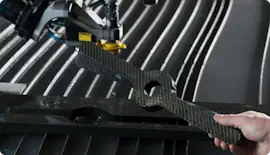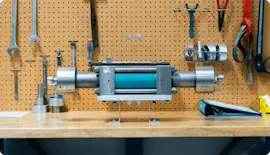Overcoming Challenges of Stone Cutting with Waterjet
In a recent survey on home buying preferences, one out of every four respondents said they preferred a custom-built home rather than a new home already built or an existing home.[1] There are many advantages to having a custom built home: unique finishes, custom floor plan, superior quality, and getting exactly what you want.
But when your customer requests a unique design, you’re often faced with several challenges, especially when it comes to trendy materials for kitchen countertops, lobby entranceways, and other living spaces in the home. As an architect or home designer, you can use software programs to easily imagine all kinds of personalized elements for a custom home. But converting those designs from the computer screen to the tangible real world? That presents an entirely different set of problems during the construction phase.
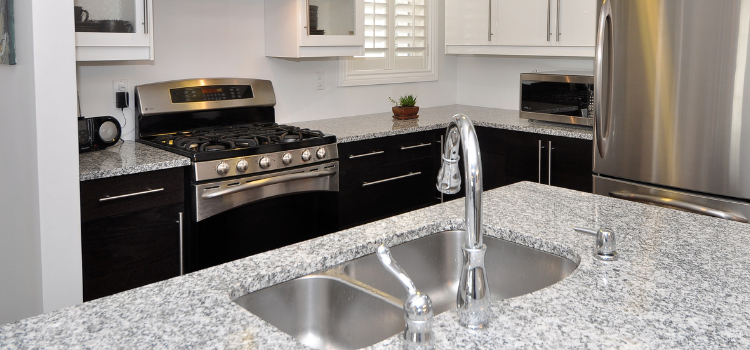
These challenges are magnified when the design involves the use of stone. Cutting granite, marble, slate, limestone, soapstone, travertine, engineered stone for intricate counter and floor designs can result in major manufacturing headaches.
The waterfall concept, in contrast, drops down vertically from the sides creating a continuous flow to the floor. This design requires that you cut the top of the slab at a 45-degree angle from the edge and then glue the drop-down piece to give the impression of a thicker piece of marble down to the floor. This intricate design introduces an especially tricky cutting problem.
Additional cutting challenges comes when customers request the use of man-made rather than natural materials. Many of these manufactured materials are non-porous, naturally resistant to bacteria and mold, durable, and easy to maintain. That’s the good news. The bad news is that these materials are extremely brittle and difficult to cut.
Sintered stone is another man-made material gaining in popularity. It is created by exposing minerals to extremely high temperature and pressure, creating an incredibly strong and durable surface, resistant to heat, abrasions, and scratches. Again, all positive attributes for the end customer. But the manufacturing process to create this material introduces serious issues when it comes to cutting. The high amount of tension can cause the material to shatter when cutting with conventional bridge saws.
The move to these types of materials isn’t going away. So how are you going to address the resulting cutting challenges?
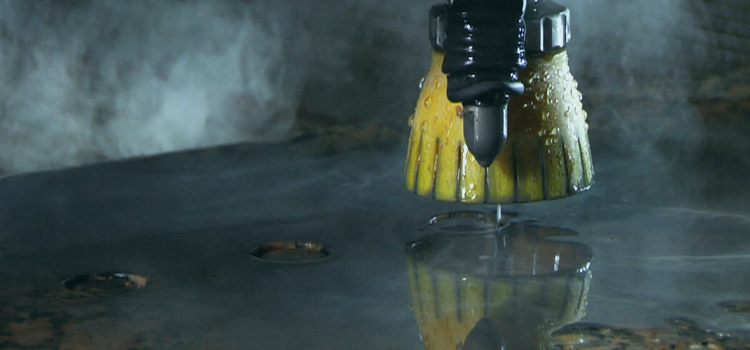
There are a number of advantages waterjet has over traditional cutting tools when it comes to cutting stone or tile.
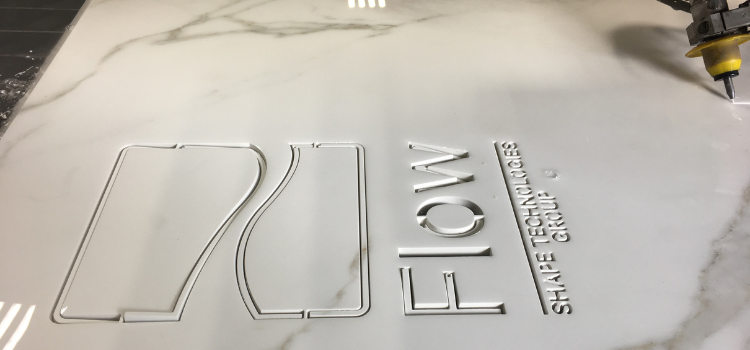
With the Flow waterjet units, Trujillo has been able to grow his business while keeping costs down. The company’s work involves the mostly high end, million-dollar custom home market which requires high quality to meet the intricate, unique design requirements.
“We couldn’t do the work we do without the waterjet technology,” Trujillo said. “Our competitors can’t do the type of work we do because they don’t have waterjet systems. They come to me for their high quality, tough cutting needs.”
The company employs eight people and brings in extra contract labor to help during peak demand periods. They are now able to do complicated work like waterfall counters two to three times faster than they could with conventional cutting tools. The raw material savings and increased productivity have been a boom to his business.
“Waterjet technology has been key to the success of my business,” said Trujillo. “If you want to take your business to the next level, you should invest in waterjet.”
[1] Trends in Home Buyer Preferences, Housing Economics.com, October 1, 2018.
But when your customer requests a unique design, you’re often faced with several challenges, especially when it comes to trendy materials for kitchen countertops, lobby entranceways, and other living spaces in the home. As an architect or home designer, you can use software programs to easily imagine all kinds of personalized elements for a custom home. But converting those designs from the computer screen to the tangible real world? That presents an entirely different set of problems during the construction phase.

These challenges are magnified when the design involves the use of stone. Cutting granite, marble, slate, limestone, soapstone, travertine, engineered stone for intricate counter and floor designs can result in major manufacturing headaches.
Cutting stone: What could possibly go wrong
Recent design trends look great when they jump off the page of the latest interior design magazine and in fact the finished product can be extremely attractive – if the components are properly cut. Many contemporary kitchen and bathroom designs include waterfall countertops – a very different construction from traditional countertops which involve a single horizontal surface that ends at the edge of an island, peninsula, or bank of cabinets.The waterfall concept, in contrast, drops down vertically from the sides creating a continuous flow to the floor. This design requires that you cut the top of the slab at a 45-degree angle from the edge and then glue the drop-down piece to give the impression of a thicker piece of marble down to the floor. This intricate design introduces an especially tricky cutting problem.
Additional cutting challenges comes when customers request the use of man-made rather than natural materials. Many of these manufactured materials are non-porous, naturally resistant to bacteria and mold, durable, and easy to maintain. That’s the good news. The bad news is that these materials are extremely brittle and difficult to cut.
Sintered stone is another man-made material gaining in popularity. It is created by exposing minerals to extremely high temperature and pressure, creating an incredibly strong and durable surface, resistant to heat, abrasions, and scratches. Again, all positive attributes for the end customer. But the manufacturing process to create this material introduces serious issues when it comes to cutting. The high amount of tension can cause the material to shatter when cutting with conventional bridge saws.
The move to these types of materials isn’t going away. So how are you going to address the resulting cutting challenges?
Waterjet to the Rescue
Fortunately, there is a solution to working with difficult natural and man-made stone materials: waterjet cutting technology. Whether you’re cutting natural or engineered stone or other material for floors and counters, you can rely on the abrasive waterjet’s unique ability to cut intricate designs at high speed without breakage. This advanced technology is the key that enables you to bring these imaginative designs to life. Compared to traditional cutting tools and CNC machines, Waterjet cutting systems are easy to use, dramatically increase productivity, and reduce costs when working with stone, glass, and tile.
There are a number of advantages waterjet has over traditional cutting tools when it comes to cutting stone or tile.
- No heat or surface stress introduced ensuring the stone or tile retains its original appearance and strength.
- Minimal kerfs which improve material utilization, reduces costs, and increasing profits.
- Virtually no chipping on the edge even on thin materials.
- Reduced scrap and significant raw material savings.
- Low operating costs with long cutting nozzle life and light flexible tooling.
- Omni-directional cutting eliminates constant repositioning on the cutting bed.
- Minimal lateral and vertical forces eliminate need for extensive parts clamping.
- Single-pass cutting for most materials.
- Net or near-net cutting reduces need for hand finishing.
Real World Results
Juan Trujillo, owner of Atlanta Natural Stone, has experienced the benefits of waterjet technology first hand. He has been a Flow Waterjet customer for over two years and now has two units – Mach 2B and Mach 200. Prior to bringing in the waterjet systems he used bridge saws and performed tough cuts by hand.
With the Flow waterjet units, Trujillo has been able to grow his business while keeping costs down. The company’s work involves the mostly high end, million-dollar custom home market which requires high quality to meet the intricate, unique design requirements.
“We couldn’t do the work we do without the waterjet technology,” Trujillo said. “Our competitors can’t do the type of work we do because they don’t have waterjet systems. They come to me for their high quality, tough cutting needs.”
The company employs eight people and brings in extra contract labor to help during peak demand periods. They are now able to do complicated work like waterfall counters two to three times faster than they could with conventional cutting tools. The raw material savings and increased productivity have been a boom to his business.
“Waterjet technology has been key to the success of my business,” said Trujillo. “If you want to take your business to the next level, you should invest in waterjet.”
[1] Trends in Home Buyer Preferences, Housing Economics.com, October 1, 2018.

